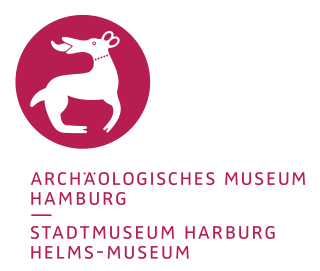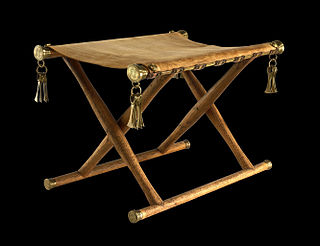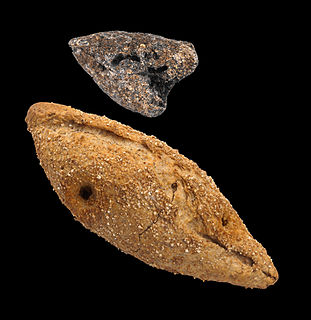
Sutton Hoo near Woodbridge, in Suffolk, England, is the site of two early medieval cemeteries that date from the 6th to 7th centuries. Archaeologists have been excavating the area since 1939. One cemetery had an undisturbed ship burial with a wealth of Anglo-Saxon artefacts; most of these objects are now held by the British Museum. Scholars believe Rædwald of East Anglia the most likely person to be buried in the ship. The site is important in understanding the Anglo-Saxon kingdom of East Anglia and the early Anglo-Saxon period, as it illuminates a period that lacks historical documentation.

Cro-Magnon is an Aurignacian site, located in a rock shelter at Les Eyzies, a hamlet in the commune of Les Eyzies-de-Tayac-Sireuil, Dordogne, southwestern France. Abri de Cro-Magnon is part of the UNESCO World Heritage of the Prehistoric Sites and Decorated Caves of the Vézère Valley.

The Lusatian culture existed in the later Bronze Age and early Iron Age in most of what is now Poland and parts of the Czech Republic, Slovakia, eastern Germany and western Ukraine. It covers the Periods Montelius III to V of the Northern European chronological scheme.
The Arras culture is an archaeological culture of the Middle Iron Age in East Yorkshire, England. It takes its name from the cemetery site of Arras, at Arras Farm, (53.86°N 0.59°W) near Market Weighton, which was discovered in the 19th century. The site spans three fields, bisected by the main east-west road between Market Weighton and Beverley, and is arable farmland; little to no remains are visible above ground. The extent of the Arras culture is loosely associated with the Parisi tribe of pre-Roman Britain.

The Prehistory of Siberia is marked by several archaeologically distinct cultures. In the Chalcolithic, the cultures of western and southern Siberia were pastoralists, while the eastern taiga and the tundra were dominated by hunter-gatherers until the late Middle Ages and even beyond. Substantial changes in society, economics and art indicate the development of nomadism in the Central Asian steppes in the first millennium BC.

La Chapelle-aux-Saints is a commune in the Corrèze department in central France.

The Archäologisches Museum Hamburg is an archaeological museum in the Harburg borough of Hamburg, Germany. It houses the archaeological finds of the city of Hamburg and the neighbouring counties to the south of the city. It focuses on northern German prehistory and early history as well as the history of the former city of Harburg. The museum is also home to the cultural heritage landmarks commission of the city of Hamburg and the adjacent district of Harburg in Lower-Saxony and thus supervises all archaeological undertakings in the region.
Joachim Werner was a German archaeologist who was especially concerned with the archaeology of the Early Middle Ages in Germany. The majority of German professorships with particular focus on the field of the Early Middle Ages were in the second half of the 20th century occupied by his academic pupils.

The Slab Grave culture is an archaeological culture of the Late Bronze Age and Early Iron Age Mongols. According to various sources, it is dated from 1,300 to 300 BC. The Slab Grave Culture became an eastern wing of a huge nomadic Eurasian world which at the beginning of the 1st millennium BC produced a civilization known as Scythian-Siberian. The anthropological type of the population is predominantly Mongoloid, the western newcomers from the area of Tuva and north-western Mongolia were Caucasoids.

Horse burial is the practice of burying a horse as part of the ritual of human burial, and is found among many Indo-European peoples and others, including Chinese and Turkic peoples. The act indicates the high value placed on horses in the particular cultures and provides evidence of the migration of peoples with a horse culture. Human burials that contain other livestock are rare; in Britain, for example, 31 horse burials have been discovered but only one cow burial, unique in Europe. This process of horse burial is part of a wider tradition of horse sacrifice. An associated ritual is that of chariot burial, in which an entire chariot, with or without a horse, is buried with a dead person.

The Wittmoor bog trackway is the name given to each of two historic corduroy roads, trackway No. I being discovered in 1898 and trackway No. II in 1904 in the Wittmoor bog in northern Hamburg, Germany. The trackways date to the 4th and 7th century AD, both linked the eastern and western shores of the formerly inaccessible, swampy bog. A part of the older trackway No. II dating to the period of the Roman Empire is on display at the permanent exhibition of the Archaeological Museum Hamburg in Harburg, Hamburg.

The Duvensee paddles is the preserved part of a Mesolithic spade paddle, which was found during archaeological excavations of a Mesolithic dwelling area at Duvensee near Klinkrade Schleswig-Holstein, Germany in 1926. After a paddle from Star Carr in England, the Duvensee paddle is the second oldest known paddle and is considered among the earliest evidence for the use of water transport in the Mesolithic. The find is in the permanent exhibition of the Archaeological Museum Hamburg in Harburg, Hamburg.

The Daensen folding chair consists of the metallic remains of a folding chair which were discovered in 1899 in sand from a Bronze Age tumulus near Daensen, a part of Buxtehude, Lower Saxony, Germany. The chair is the southernmost and most richly decorated example of the eighteen known folding chairs of the Nordic Bronze Age in Northern Europe. The fittings, along with a reconstruction, are in the permanent exhibition of the Archaeological Museum Hamburg in Harburg, Hamburg.

The Tangendorf disc brooch is an Iron Age fibula from the 3rd century AD, which was dug up in 1930 from the sand of a Bronze Age tumulus near Tangendorf, Toppenstedt, Harburg, Lower Saxony, Germany. The front of the elaborately crafted garment fibula is decorated with a rear-facing four-legged animal, probably a dog or a deer. It is one of Harburg's most important finds from the period of the Roman Empire, and is in the permanent exhibition of the Archaeological Museum Hamburg in Harburg, Hamburg.

The Ovelgönne bread roll is the remaining part of a bread roll originating from the Pre-Roman Iron Age of Northern Europe, which was found in 1952 during archaeological excavations in a loam mine in the Buxtehude district Ovelgönne in Lower Saxony, Germany. The piece of bread is the oldest surviving viennoiserie and formed bakery product from Europe. The find, along with a reconstruction, are in the permanent exhibition of the Archaeological Museum Hamburg in Harburg, Hamburg.

The Metzendorf-Woxdorf head of burial is the Neolithic burial of a single human skull that was found in 1958 in the Seevetal district of Woxdorf, in Harburg, in Lower Saxony. The find is currently the only one of its kind of the Single Grave Culture in Germany and is in the permanent exhibition of the Archaeological Museum Hamburg in Harburg, Hamburg.

The Maschen disc brooch is an Early Medieval fibula, which was found in 1958 during archaeological excavations of the late Saxon grave field near Maschen, in the Lower Saxony district of Harburg, Germany. On its face side, the fibula shows an unidentified saint with a halo. It was found in a woman's grave of the beginning of the Christianization of northern Germany, and is in the permanent exhibition of the Archaeological Museum Hamburg in Harburg, Hamburg.

The Necropolis of Soderstorf is a prehistoric cemetery in the valley of the Luhe river valley near Soderstorf in the Lüneburg district of Lower Saxony, Germany. The site was used for more than 2000 years. It includes a megalithic tomb, a tumulus tomb, a stone circle, paving stones, funerary urns and a flat grave.

The Anker Site (11Ck-21) is located on the Little Calumet River near Chicago, Illinois. It is classified as a late Prehistoric site with Upper Mississippian Huber affiliation.

The Gentleman Farm Site is located in LaSalle County, Illinois, on the Illinois River. It is a multi-component site with the main occupation being a Langford Tradition component of Upper Mississippian affiliation.




















